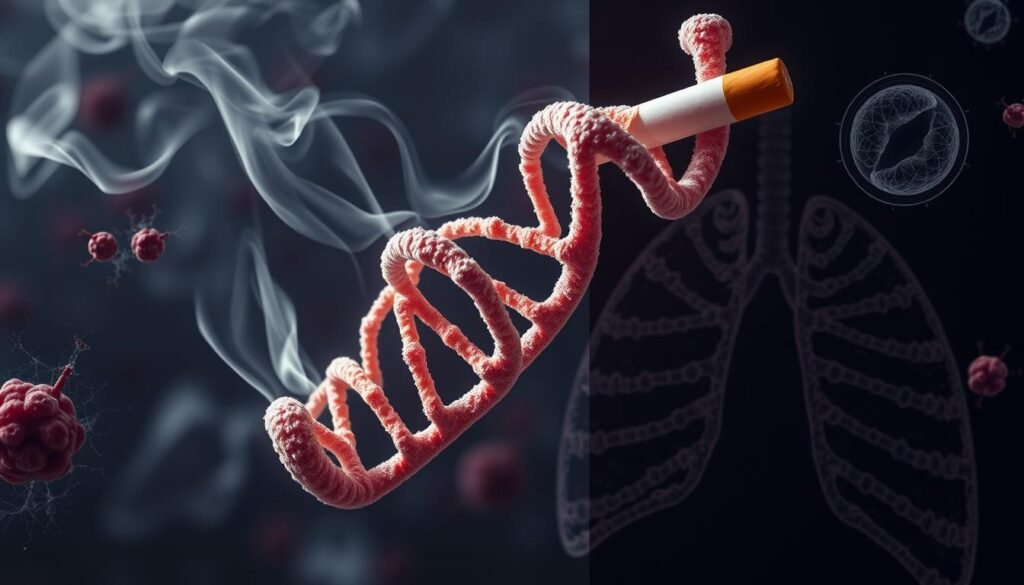Did you know about 90% of lung cancer cases come from smoking? This shows how smoking affects lung cancer rates. It also points out the need for awareness and steps to prevent this. Smokers are 15 to 30 times more likely to get lung cancer than non-smokers. Tobacco smoke has over 7,000 chemicals, with at least 70 causing cancer. The stats on cancer deaths from smoking are eye-opening. Quitting smoking is good, but ex-smokers still have a high risk of lung cancer.
Key Takeaways
- Approximately 90% of lung cancers are caused by cigarette smoking.
- Exposure to cigarettes could prevent as many as 90% of lung cancer diagnoses.
- Family history of lung cancer doubles the risk for smokers.
- Secondhand smoke significantly increases the risk of lung cancer.
- Smoking raises the likelihood of chronic obstructive pulmonary disease (COPD).
- Cigarette smoke is linked to various serious health issues beyond lung cancer.
- Awareness and prevention play crucial roles in reducing lung cancer risk.
The Link Between Smoking and Lung Cancer
Smoking is closely linked to lung cancer. It’s responsible for 80% to 90% of lung cancer deaths. This shows how big of a role smoking plays in causing this disease. Smokers are 15 to 30 times more likely to get lung cancer than non-smokers. Even those who smoke lightly or occasionally are at higher risk. This means no amount of smoking is safe.
Understanding the Statistics
In the United States, smoking leads to a huge number of lung cancer cases. In 2007, lung cancer caused over 160,000 deaths. It accounts for 31% of all cancer deaths in men and 26% in women. Lung cancer is now the top cancer killer, above breast, prostate, and colon cancers combined. The five-year survival rate is only about 15%, which highlights the severity of lung cancer.
Defining Lung Cancer Types
Lung cancer comes in two main types: non-small cell lung cancer (NSCLC) and small cell lung cancer (SCLC). NSCLC is broken down further into subtypes like adenocarcinoma, squamous cell carcinoma, and large cell carcinoma. Among these, adenocarcinoma is the most common subtype. Knowing about these types is key for treatment and awareness. It helps us understand how smoking is linked to lung cancer.
How Tobacco Affects Lung Health
Tobacco smoke is very harmful to lung health because of tar and carcinogens. Smokers face a far higher risk of developing diseases compared to nonsmokers. Tar, which is a sticky substance, builds up in the lungs. It can cause cancer cells to grow. Knowing about tar’s dangerous effects is critical for everyone’s health.
The Role of Tar and Carcinogens
Tobacco smoke changes lung tissue right away because of the carcinogens in it. Cigarette smoke has over 5,000 chemicals, and 73 of them can cause cancer. These carcinogens harm the DNA in lung cells. This greatly raises the chance of lung cancer. This fact shows how bad tobacco is for our lungs. It also shows why smoke-free places are very important.
Nicotine Addiction Explained
Nicotine makes people depend on smoking. This dependency means they keep being exposed to tobacco’s dangers, which increases lung cancer risk. Quitting smoking cuts this risk. After not smoking for ten years, the lung cancer risk is much lower. Teaching people about nicotine addiction helps them make better choices about smoking.
https://www.youtube.com/watch?v=gwuwrRK-I2Y
It’s key to understand tobacco addiction to fight the smoking-related illness epidemic. Support for patients, no matter their smoking past, is crucial. This support helps fight lung cancer stigma and encourages healthy living.
Research highlights the importance of understanding how smoking badly affects health.
Smoking Cigarettes Increases the Risk of Developing Lung Cancer By Significant Margins
Smoking cigarettes plays a big role in getting lung cancer. The length of time and how often you smoke matter a lot. If you smoke right after getting up or regularly, your risk goes up. Working around things like asbestos, arsenic, and diesel exhaust can also make lung cancer more likely.
Impact of Smoking Duration and Frequency
Studies show how smoking time and frequency can increase your lung cancer risk. If you smoke within 30 minutes of waking up, your chances of having lung cancer are much higher, with an odds ratio of 3.56. Smoking every day also increases your risk:
| Cigarettes Smoked Per Day | Odds Ratio for Lung Cancer |
|---|---|
| 10–19 | 1.4 |
| 20–29 | 2.20 |
| 30–39 | 2.6 |
| 40–49 | 3.5 |
| 50+ | 4.0 |
Smoking for years adds up, greatly increasing lung cancer risk. It’s vital to cut back or quit smoking to reduce your chances.
Occupational Risks and Additional Factors
Job risks also play a big role in lung cancer. Being around harmful substances at work adds to the danger. These include:
- Asbestos
- Radon
- Diesel exhaust
- Arsenic
Living where the air is very polluted can also raise your risk. Together, these things show how complex lung cancer risks are. It underlines the importance of focusing on preventing it.
The Case of Secondhand Smoke
Secondhand smoke poses significant dangers, especially for those who do not smoke themselves. Studies show even non-smokers can suffer severe health problems from exposure. For example, many people develop serious conditions from being around smokers. Families and communities often overlook these dangers. This oversight is particularly alarming for children and pregnant women.
Health Risks for Non-Smokers
The health risks linked with secondhand smoke are extensive. Non-smokers exposed to it are more likely to face various health issues. Here are the risks non-smokers face from secondhand smoke exposure:
- Risk of lung cancer rises by 20–30% among non-smokers.
- Higher chances of coronary heart disease, increasing by 25–30%.
- Stroke risk rises by 20–30% for those exposed.
- Approximately 34,000 premature deaths from heart disease occur annually in non-smoking adults due to secondhand smoke.
- More than 7,300 deaths from lung cancer happen each year among U.S. non-smokers.
- Women exposed during pregnancy can face lower birth weights in their babies, leading to health complications.
- Children face heightened risks of asthma attacks, respiratory infections, and ear infections.
Statistics on Secondhand Exposure
Statistics about secondhand smoke reveal its serious impact on public health. The data show worrying trends. They help us understand the danger posed by passive exposure:
| Statistic | Impact |
|---|---|
| Lung Cancer Mortality (Non-Smokers) | More than 7,300 deaths annually |
| Coronary Heart Disease | 34,000 premature deaths each year |
| Increased Risk of Stroke | 20–30% for exposed adults |
| Risk of Asthma in Children | Higher likelihood of attacks and infections |
| Low Birth Weight in Newborns | Higher chance due to maternal exposure |

Health Risks Associated with Smoking
Smoking does more than just lead to lung cancer. It can cause severe problems like emphysema and chronic bronchitis. These fall under Chronic Obstructive Pulmonary Disease (COPD). This condition comes from lung harm due to tobacco smoke’s dangerous chemicals. It causes inflammation and big breathing issues.
Emphysema and Chronic Bronchitis
Emphysema slowly breaks down the alveoli in your lungs. This makes it hard to breathe. Chronic bronchitis means you have a long-term cough and mucus. Smoking can lead to these tough conditions. They make life harder and can cause more health problems.
Understanding the link between COPD and higher lung cancer risk is key. The symptoms of these diseases can be similar. That makes it important to diagnose them right away. If you have COPD, you’re more likely to get lung cancer, so early care is crucial.
Cardiovascular Disease and Premature Aging
Smoking greatly increases your risk of heart disease, including heart attacks and strokes. The toxins in tobacco harm your blood flow and blood vessels. This can cause serious heart problems. Smoking also leads to aging faster. It affects how long you might live and your overall health.
Smoking causes many health problems. It’s important to know these risks and take steps to avoid them. If you smoke or used to, keep an eye on your health. You might even need yearly checks for lung cancer. This is especially true if you’ve smoked for a long time.
| Health Condition | Impact |
|---|---|
| Emphysema | Destroys lung tissue, limits airflow |
| Chronic Bronchitis | Causes persistent cough and mucus, restricts breathing |
| Cardiovascular Disease | Increases risk of heart attack and stroke |
| Premature Aging | Affects overall health and longevity |
Genetic Susceptibility to Lung Cancer
Genes play a big role in someone’s chance of getting lung cancer. Knowing about these genes helps us understand why some people might get sick, especially if they are around harmful things like smoke. Studies show that our genes interact with our actions, like smoking, to affect our lung cancer risk.
Inherited Risk Factors
If lung cancer runs in your family, your risk goes up. This is because genetic mutations can be inherited. For smokers with a specific mutation on chromosome 15, their lung cancer risk jumps by 30% to 80%. This means they have a 20% to 23% chance of getting lung cancer.
Scientists have found over 100 areas in our DNA linked to health problems. Among them, certain changes in chromosome 15 are tied to lung cancer. These changes are connected to how many cigarettes someone smokes each day. About 13.7% of people with lung cancer have a close relative with the same illness.
When looking at families with several lung cancer cases, certain trends stand out. In families with four or more sick members, lung cancer chances go way up. Research also shows that smokers, whether they have these genetic risks or not, are three times more likely to get lung cancer. These findings underline the strong link between our genes, smoking, and lung cancer.
| Risk Factors | Impact |
|---|---|
| Chromosome 15 mutation | Increases lung cancer risk by 30% to 80% for smokers |
| Family history of lung cancer | 13.7% of patients have a first-degree relative with lung cancer |
| SNP variation at 15q24 | Correlated with the number of cigarettes smoked daily |
| Multiple affected family members | Mean age of onset is 60 years for lung and related cancers |

Tobacco Cessation and Lung Cancer Risk Reduction
Quitting smoking greatly lowers lung cancer risk. Studies prove quitting brings quick health benefits. This motivates people to stop using tobacco. Former smokers have a lower lung cancer risk than current smokers. Yet, their risk is higher than those who never smoked.
Health Improvements After Quitting
Many health benefits come from quitting. These include better lung function and lower heart disease risk. The body starts healing right away. Benefits can show in just hours or days after the last cigarette. Over time, quitting smoking offers major rewards, such as:
- Decreased risk of lung cancer by up to 60% after 10 years.
- Half the risk of mouth and esophagus cancers within 5 years.
- Better heart health and lung capacity.
Long-Term Benefits of Early Cessation
Stopping smoking early has big long-term benefits. People avoiding major health issues by quitting see big well-being boosts. Quitting smoking reduces lung cancer risk and leads to:
- A longer life.
- Improved breathing and quality of life.
- Less chance of chronic diseases from smoking.
Quitting programs help a lot. They offer counseling and group support. Quitting has many benefits, showing why a smoke-free life is important.
Impact of Lifestyle Choices on Lung Cancer Risk
Lifestyle choices are key in determining lung cancer risk. By knowing dietary and environmental risks, people can make better health choices.
Dietary Factors and Their Influence
Dietary factors greatly affect lung cancer risk. Some foods may lower it, while others can increase it. Eating lots of fruits and vegetables may reduce the risk, due to antioxidants. On the other hand, processed foods and meats might increase it. It’s crucial to have a balanced diet for your health.
Environmental Considerations
The environment greatly influences lung cancer risk. Bad air, pollution, and exposure to dangerous work chemicals raise the risk. Smoking is the top cause, but environment matters too. It’s important to know your environment and reduce contact with harmful substances. Knowing environmental risks can help lower lung cancer risk. For more info on lung cancer risks, visit this resource.

Global Trends in Smoking and Lung Cancer Incidence
The link between smoking and lung cancer tells a powerful story about health worldwide. As nations adopt different smoking habits and health policies, lung cancer rates show those choices clearly. Looking at how countries compare highlights the real outcomes in places where many people smoke.
Comparative Statistics Across Countries
Lung cancer is a major health problem globally, causing about 1,590,000 deaths in 2012. In Central and Eastern Europe, lung cancer deaths were highest for men, reaching 47.6 per 100,000 people. In Eastern Asia, this rate was 44.8. But, in sub-Saharan Africa, the rates were much lower, at 4.4 for men and just 2.2 for women.
Lung cancer is the top cause of cancer deaths in many countries, affecting men in 87 nations and women in 26. The highest death rates for men were in Hungary (66.6), Armenia (65.6), and other places in Eastern Europe. For women, the highest rate was in North Korea (30.7), with Denmark and Canada also high up the list.
This comparison shows the clear link between smoking rates and lung cancer. With around 30% of cancer deaths from smoking, fighting tobacco use is key to better health. Efforts to combat smoking have cut cancer cases across many regions, with a 1.3% annual decrease from 2004 to 2013.
Conclusion
The link between smoking and lung cancer is very clear. It shows why we need strong actions against tobacco use. Studies show a big rise in lung cancer risk for smokers, men, and women alike. Most lung cancer deaths, about 90%, are due to smoking.
This fact makes it clear how important it is to stop people from starting to smoke. It’s not only about lung cancer. Smoking also leads to many other health problems. These include chronic obstructive pulmonary disease (COPD) and heart diseases.
Telling people about the dangers of smoking is crucial. We need to keep spreading the word on how risky smoking is. Also, supporting programs that help people quit smoking is key. People who stop smoking lower their cancer risk a lot. They start to see health benefits just a few weeks after quitting.
If we focus on stopping smoking and improve health teachings, we can reduce smoking rates. This doesn’t just lower lung cancer cases. It also makes the whole population healthier. For more on how smoking affects lung cancer, check this detailed overview.